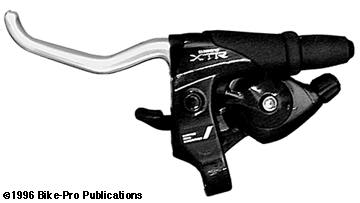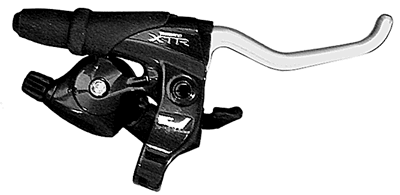
Shimano is the major company making Brake / Shift levers for mountain use. Please read these reviews in the order presented, so we can avoid explaining the same principles with each of the three items. We chose top write about the XTR first because it is the longest in production of the 3 and wanted to discuss how the Rapid Fire shifter has changed in the current Optical Gear Display version. Incidentally this the last year the M900 will be made. For 1995 Shimano will introduce an OGD version of the XTR brake/shifter.
We want to remind you that all indexing systems for shifting reside only in the shifter. Any rear derailleur can be used with any indexed shifter, there are some very fine adjustments that are invisibly built into "systems" but the indexing will function with any index shifter. Some makers of bike parts have chains and rear gears that might add speed to achieving the shift. These Shimano shift systems are designed to use the industry standard of 4.8mm spacing on-center between rear sprockets. They will work with any rear changer, chain, or cassette...no matter who made it.


The M900 was first released in the 1992 model year (late 1991) and is the first of the 8 speed off road components groups. We are going to discuss the brake lever aspect of the M900 first. The handle and clamp section are both made of forged aluminum. The handle's installation into the clamp section is a complicated affair. The complexity comes from wanting the lever to function smoothly, have "ServoWave" capability and keep the handle fastening system largely hidden.
There are many riders who have the belief that "ServoWave" makes active the brake cable housing, by pushing on the housing while the cable is being pulled through its interior. This is myth that has stood un-corrected.
The lead end of the brake cable fits into a Black plastic cable anchor. The cable anchor is pinned to the arm and slides back and forth smoothly as it is pulled backward by the handle. This plastic cable end anchor slides well ahead of the handle inside the clamp housing and allows fast braking because it isn't dependent on the pivot feature to draw the cable slack up first before pulling the cable. The pin that passes through the plastic anchor holding it to the handle has cylindrical nylon ends. These nylon ends function as "cam followers" inside the clamp housing to make the "Servo-Wave" feature. Inside the housing on each side is a set of ledges that these nylon rollers run against as the lever pulls the plastic cable end anchor.
The ledges have dips or "waves" built into them. As the nylon tipped pins roll over a peak inside the housing the brake cable is pulled more taunt, when they reach a dip or trough the cable becomes momentarily relaxed. This taunt and relax repetition, creates brake modulation, pulsing brake pad firmness through the pad contact. (You can't steer a wheel that isn't turning, it can only skid the wheel, this is the principle behind Anti-Lock Braking in automobiles.) One of the cam ledges to make the "wave" pattern is forged as a part of the aluminum housing. The other mated ledge or "cam" is molded of nylon plastic and held in place to the front of the lever with a tiny steel bolt and nut.
As the firmness of the riders grip continually changes the modulation/"servo-wave" condition gets continually repeated. The handle has a machined steel bushing that it pivots on. With the lever and cable anchor in place inside the housing, the steel bushing slides through the housing and handle. A tiny set screw with a 2mm hex fitting is tightened down onto a detent in the center of the bushing. The set screw holds the bushing and handle in place. This tiny set screw isn't likely to loosen up and is unable to fall off the lever set in use. Its position is covered by the lever return spring. Carbonworks makes a carbon fiber replacement for this aluminum handle. The original weighs 34 grams, the carbon replacement weighs 18.5 grams. Changing one for the other can be performed in 3 minutes by even an amateur, and the carbon replacement has the needed 2mm bushing set screw and the steel pin for the lever return spring to push on.
The M900 uses the two piece telescoping spring system found in the M733 XT brake lever. The spring is a the type used in a retractable ball point pen and is encased in a plastic capsule. One end has a hook shape and presses against a steel pin passing through the handle. The other end is round and fits into a round dimple in the clamp housing near the fastening bolt. The reach adjustment feature of this lever is more traditional than the rotating cam used in the M733 XT levers. In the M900 case a small steel set screw is used. Its 2mm hex fitting is accessed from the top of the lever near the shifter.
The lever fastening bolt which tightens the brake/shift lever to the handlebar is made of steel. It has 6mm by 1mm pitched threads, a 5mm hex fitting for tightening, a 15.5mm length and a 3.5 gram weight. The brake cable barrel (convenience) adjuster is made of aluminum with 10mm by 1mm pitched threads and a 4 gram weight. The piece is cut lengthwise to accommodate rapid cable installation. A Black plastic fixing nut is used to hold the barrel adjuster in place once set. The last brake lever piece is a rubber hood that fits over the cable adjuster pieces and tightly closes off completely access to the brake cable. The brake lever has 60mm of finger grip area.
The shifter assembly is mounted to the lever clamp assembly with a small steel bolt. The bolt has 5mm by .8mm threads, a 5mm hex fitting for tightening, a 11mm length and a 2.5 gram weight. This bolt can be replaced with Titanium water bottle cage bolt. The upper housing of the shifter is made of three pieces. There is an upper and lower Grey plastic shroud that enclose a stamped steel shifter position piece which also holds the shift cable barrel (convenience) adjuster. The position piece has four pins that emerge from its top surface. These fit into recessed holes in the bottom of the clamp assembly. There is just one way for the position to fit, and there are small arrows that line up to show the correct position.
The shifter mechanism also uses four pins to fix its position to the bottom of the position plate. When each of the parts are lined up and bolted, the lever clamp assembly holds all the pieces rigid relative to the handlebar. Pressing of the shift levers make the mechanism work around this mechanically fixed position. The inner workings of the shifter aren't important in this discussion and even Shimano replaces the shift mechanism entirely under warranty rather train people in small parts replacement which may not be effective. A lower plastic cover bolts into place protecting the inner shift parts. The shifter inner wire can easily be replaced. A hole through the shroud on the shifterÕs outer side is made to slide out the old and slip in a new shift wire. The shift cable convenience adjuster is made of steel, and under spring pressure to shorten the cable if revolved. Around the adjuster is a finger grip made of Grey plastic.
Theory of operation of the left or front chain ring shifter. There are two levers placed one over the other. The lower lever, when pressed shifts the chain to a larger chain ring. The lower lever, if pressed just halfway to the first "click" shifts the chain up just one chainring. If it's pressed the full travel distance it will shift the chain up two chain rings. The upper lever sits just ahead of and below the handlebar behind the brake lever and is meant to be actuated by the index finger. It has a total travel distance of 12mm Each time the upper lever is pulled toward the handlebar, the chain drops back just one chain ring. Two pulls of the upper lever bring you to the smallest (inner) from the biggest (outer).
Theory of operation of the right or rear sprocket shifter. Like the left lever there is two levers, one over the other. The lower lever accomplishes "up" shifts to lower gears on the rear hub. The lower lever has four "detents" or positions of momentary stop along its rotation. Pressing the lever to the first detent produces a "click" sound and a one gear rear upshift. If you chose, you can continue pressing the lever to the second detent where a second "click" will sound and another upshift will be performed. Continuing to press the lever will bring you to the third detent, with a third "click" and upshift. When pressed fully, you will hear the fourth click and four upshifts will have been performed. You do not have to slow down in the pressing of the shifter.
The four stage shift can be performed with a large lunge on the lever. The shifter, rear derailleur and chain will work out the details. If you try to push the lever beyond the lowest gear, meaning you have fully down shifted, the lever stops moving and won't allow you to shift further until you pull the upper trigger to up-shift. Though the XTR set has 8 speed rear gearing, to go from the highest (smallest) gear to the lowest (largest) will require two presses of the right up shift lever. The upper lever, like the left lever, is positioned ahead of the handlebar but behind the brake lever and has just 15mm of travel when pulled back toward the handlebar. Meant to be operated by the index finger, each pull slackens the shift cable so the rear dŽrailleur will shift once to a smaller (higher) gear. Shifting from the lowest (largest) gear to the highest (smallest) will require 7 separate index finger pulls.
The M900 set comes with a well constructed, heavy duty brake cable set with Grey housing weighing 166 grams. Shimano also includes a shift cable set and matching Grey housing weighing 89 grams. The rubber hoods on the brake lever weighs 12.5 per pair, while the brake lever part of the set weighs 213.5 grams. The right shift system with bolt weighs 97.5 grams, the left with bolt is 84.5 grams. The total set weight is 663 grams. This original model has been replaced by the 1995 model that has the optical gear display. The original sold for $149.99